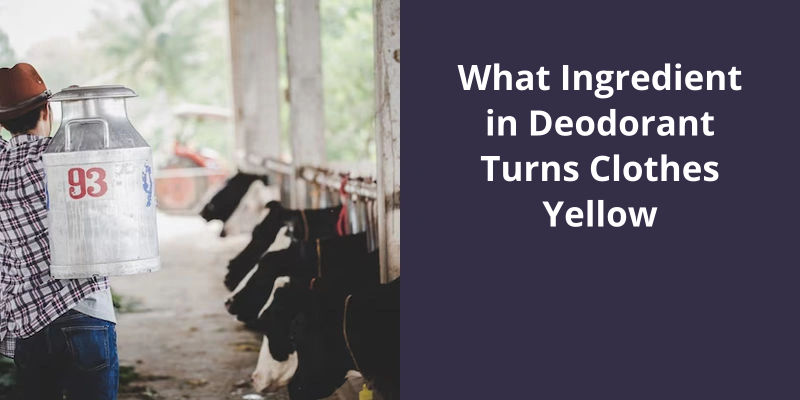The ingredient in deodorant that turns clothes yellow is aluminum. Aluminum is commonly used in antiperspirants because it helps to block the sweat glands, reducing the amount of sweat produced. But when it combines with the sweat on your body, it can cause a chemical reaction that results in the yellowing of clothes, particularly in the underarm area. The yellow stains are particularly noticeable on white and light-colored clothes.

Why Does My Deodorant Turn My Clothes Yellow?
Many people have experienced the frustration of yellow stains appearing on their clothes after using deodorant or antiperspirant. These unsightly stains can be particularly noticeable on white or light-colored garments. So, why does this happen?
Sweat naturally contains minerals like salt, and when these minerals mix with the aluminum compounds in antiperspirant, a chemical reaction occurs, leading to the formation of the yellow stains on clothing.
To prevent or minimize yellow stains on clothing, some steps can be taken. Opting for aluminum-free or low-aluminum antiperspirants or deodorants may be helpful, as these products will have a reduced chance of causing the yellowing effect. Choosing products that contain alternative sweat-blocking ingredients, like natural minerals or baking soda, may also be worth considering.
It’s important to let the product absorb into the skin and form a protective barrier before getting dressed.
Is There a Difference Between Deodorants and Antiperspirants When It Comes to Causing Yellow Stains?
Deodorants and antiperspirants can both contribute to yellow stains on clothes, but they do so through different mechanisms. The primary culprit behind these stains is often aluminum-based compounds found in antiperspirants. These compounds can react with sweat and natural body oils, creating yellow discoloration on fabrics. Deodorants, on the other hand, primarily mask or neutralize body odor without necessarily reducing perspiration. Therefore, while both deodorants and antiperspirants can potentially cause yellow stains, antiperspirants with aluminum are more likely to be the main culprit.
Not only can the combination of aluminium salts and ethyl alcohol in antiperspirants lead to stained shirts, but the pH levels of these substances can also contribute to discoloration. The reaction between sweat and the ingredients in deodorants causes a chemical interaction with the proteins and oils in the fabric, resulting in stubborn discoloration. However, there are ways to prevent and remove these unsightly stains.
Why Does My Deodorant Discolor My Shirts?
Why does my deodorant discolor my shirts? You might not know this, but antiperspirants contain aluminium salts and ethyl alcohol. As you sweat, your perspiration can mix with these ingredients, and as a result of this nasty cocktail, your shirts will stain. The aluminium salts in deodorants act as a form of astringent, which helps to block the pores and reduce sweat production. However, this ingredient can cause discoloration when it comes into contact with sweat. As the aluminium salts react with the proteins in sweat, they can leave behind a yellowish residue on your clothes. Furthermore, the ethyl alcohol found in deodorants can exacerbate this staining effect. Ethyl alcohol is a commonly used solvent that helps to dissolve the active ingredients in deodorants and antiperspirants. When combined with sweat, the alcohol can act as a carrier for the aluminium salts, allowing them to penetrate the fabric fibers more deeply. This can lead to more stubborn stains that are harder to remove. When you apply deodorant or antiperspirant directly to your skin, these ingredients come into contact with your sweat. The combination of sweat, aluminium salts, and ethyl alcohol can create a chemical reaction that causes the yellow stains on your shirts. It’s also worth noting that the type of fabric can play a role in how easily these stains form. Certain fabrics, such as cotton and polyester, are more prone to absorbing and retaining sweat and deodorant residues, increasing the likelihood of staining. To prevent or minimize deodorant stains on your shirts, you can try a few simple tricks. First, consider switching to a deodorant without aluminium salts. Look for natural or aluminum-free options that won’t react with sweat to form stains. You can also try applying your deodorant at least 10 minutes before putting on your shirt, allowing it to dry fully before contact with fabric. This can help reduce the transfer of deodorant residues onto your clothes. Additionally, pre-treating stains with a stain remover or laundry detergent specifically designed for protein-based stains can help break down and remove the yellow discoloration. Overall, knowing the ingredients in your deodorant and taking preventive measures can help you avoid those unsightly yellow stains on your shirts.
Tips for Removing Deodorant Stains From Shirts
- Use white vinegar to pretreat the stain.
- Gently rub the stained area with a mixture of water and baking soda.
- Apply lemon juice directly onto the stain and let it sit for a few minutes before washing.
- Try using hydrogen peroxide to remove stubborn deodorant stains.
- Use a stain remover or pre-wash treatment specifically designed for removing deodorant marks.
- Consider using a laundry detergent with enzymes to break down the stain.
- Soak the shirt in a mixture of warm water and dish soap before laundering.
- For white shirts, try using bleach or a bleach alternative to tackle the stain.
- Always check the care instructions on your shirt before attempting any stain removal method.
- If the stain persists, consider seeking professional dry cleaning services.
In addition, using clear or gel deodorants instead of the traditional white stick formulations can also minimize the chances of staining. Additionally, applying antiperspirant only at night before bed allows it ample time to dry and absorb into the skin, reducing the likelihood of it transferring onto clothing the next day.
How Do You Keep Deodorant From Staining Clothes?
When it comes to keeping your deodorant from staining your clothes, one of the most important things to do is to allow it to fully dry before dressing. This will help prevent any transfer of the product onto your clothes. To ensure proper drying time, it’s best to apply your deodorant right after showering or washing your underarms. Wait a few minutes before putting on your clothes to give the deodorant enough time to absorb into your skin.
This will help remove any accumulated sweat and antiperspirant from the fabric. Stains and spills tend to set in if left untreated, so it’s important to tackle them as soon as possible. By doing this promptly, youll be able to prevent the yellowing of your clothes caused by perspiration and antiperspirant buildup.
Another useful tip is to choose deodorants and antiperspirants that are clear or white in color rather than those with a colored formula. Clear or white products are less likely to leave visible stains on your clothes. Additionally, consider opting for a non-antiperspirant deodorant, as antiperspirants often contain aluminum compounds that can contribute to staining.
It’s worth noting that some fabrics are more prone to staining than others. Certain materials, such as silk or rayon, can be particularly susceptible to discoloration from deodorant. If you frequently wear clothes made from these fabrics, it may be helpful to use a fabric protector spray or barrier cream on the underarm area before applying your deodorant. This can create a protective barrier that minimizes product absorption and staining.
Regularly washing your clothes with an effective detergent can also help prevent deodorant stains. Look for detergents specifically formulated to remove stains or ones that are labeled as color-safe. These detergents often have enzymes or other active ingredients that target and break down proteins, which is what sweat and deodorant stains are composed of. By using the right detergent, you can help keep your clothes looking fresh and stain-free.
Tips for Removing Existing Deodorant Stains From Clothes
- Avoid rubbing the stained area vigorously, as it may push the deodorant further into the fabric.
- Gently brush off any excess deodorant using a soft cloth or a dry toothbrush.
- Apply a small amount of liquid laundry detergent directly onto the stain and let it sit for about 10 minutes.
- Using a clean cloth or sponge, gently blot the stain with cold water to help lift the deodorant residue.
- Rinse the garment thoroughly and check if the stain has been completely removed.
- If the stain persists, mix equal parts white vinegar and water and apply it to the affected area. Let it sit for a few minutes before rinsing.
- For stubborn stains, create a paste by mixing baking soda with water and gently scrub it onto the stain. Rinse thoroughly.
- Once the stain is removed, wash the garment as recommended on the care label.
In addition to the aluminum salts, other ingredients such as fragrances, oils, and waxes can contribute to discoloration of clothes. These substances can interact with fabrics and cause staining or discoloration, particularly on light-colored or delicate materials. Understanding the underlying causes of antiperspirant deodorant stains can help you take steps to prevent them and keep your clothes looking fresh and clean.
Why Is My Deodorant Discoloring My Clothes?
If you’ve ever noticed white marks or stains on your clothes, you may be wondering why your deodorant is discoloring them. The culprit behind these unsightly marks is the ingredients in antiperspirant deodorants.
One of the key ingredients in antiperspirants is aluminum salts. These salts help to reduce sweat production by forming a gel-like plug in the sweat glands. However, when these aluminum salts come into contact with the skin, they can leave behind chalky marks. These marks can then transfer to your clothes, resulting in those pesky white stains.
The answer lies in their chemical properties. Aluminum salts have a tendency to dry out when exposed to air. When you apply antiperspirant to your underarms, the aluminum salts come into contact with the moisture on your skin and start to dry out, leaving behind a white, powdery residue.
This is particularly noticeable on dark or colored clothing, where the contrast between the white marks and the fabric is more pronounced.
This is especially common on white clothing, where the yellow discoloration is more noticeable. The cause of these yellow stains is often the combination of sweat and the aluminum salts in the deodorant.
To prevent these stains and marks, you can try a few different tactics. First, opt for a deodorant without aluminum salts, such as a natural or aluminum-free alternative. Additionally, make sure to apply your deodorant evenly and allow it to dry before putting on your clothes. Finally, consider wearing an undershirt or using armpit pads to protect your clothes from any potential stains.
By choosing aluminum-free options, applying deodorant properly, and taking preventative measures, you can keep your clothes stain-free and fresh.
Source: Why do all my shirts get hard deodorant stains?..
There are times when you might notice a frustrating issue with your laundry – bluish stains appearing on the armpits of your shirts after washing. Before diving into the possible causes and solutions for this problem, it’s important to understand that overfilling the detergent or fabric softener compartments could be the culprit behind this pesky issue. In the following sections, we will explore why this happens and what steps you can take to prevent it from occurring in the future.
Why Do the Armpits of My Shirts Turn Blue After Washing?
If youve noticed blue stains appearing on the armpits of your shirts after washing, it can be quite frustrating. However, this issue might not be related to your deodorant, but rather a common laundry mistake. One possible cause of the bluish stains is overfilling the detergent or fabric softener compartments in your washing machine.
When you pour too much detergent or fabric softener into these compartments, it can lead to an excessive amount of these substances being released during the wash cycle.
To prevent this issue, make sure to carefully follow the manufacturers instructions regarding the proper amount of detergent and fabric softener to use in each load. Using the right amount of these products will help ensure that they’re adequately diluted in the water and won’t leave behind excessive residue.
Furthermore, it’s essential to thoroughly rinse your clothes during the washing process. Insufficient rinsing can leave detergent or fabric softener residue on your garments, which may contribute to the appearance of bluish stains. Consider using an extra rinse cycle or selecting a setting that offers more extensive rinsing to minimize the risk of residue buildup.
In addition to the laundry process, the composition of your shirts could also play a role in the development of blue stains. Some fabrics, particularly those containing synthetic fibers, can be more prone to color transfer or staining. If you consistently experience these stains, you may want to consider washing your colored shirts separately from your whites or using color-catching laundry products to help prevent color bleeding.
Conclusion
When this ingredient comes into contact with our sweat, a chemical reaction takes place, resulting in those unsightly yellow marks. While keeping us fresh and dry, it seems that aluminum inadvertently wreaks havoc on our clothing. By understanding the causes behind these stains, we can now explore alternative options and preventive measures to keep our favorite garments looking their best.





